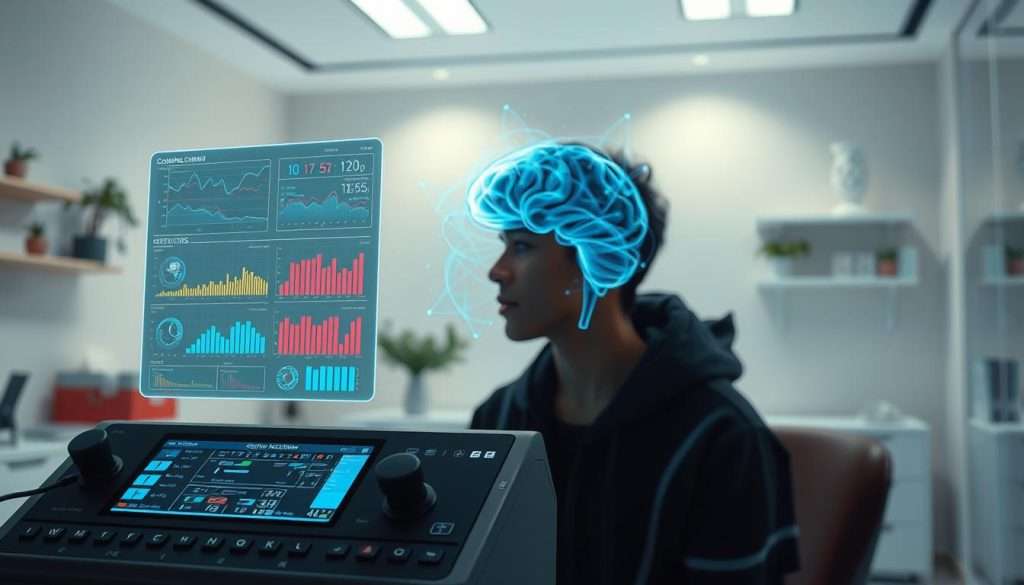Ever wondered what makes geniuses different from the rest? Is it their natural talent or something they work on? The truth is, we all can unlock our inner genius and show our intellectual prowess.
Finding your Genius Quotient (GQ) is the first step to great success. By knowing your unique genius mindset, you can open new doors and reach your highest potential. We’ll help you on this journey of self-discovery. You’ll learn to think like a genius and use your talents to the fullest.
Key Takeaways
- Discover your unique Genius Quotient (GQ) to unlock your full potential.
- Understand the concept of a genius mindset and how to cultivate it.
- Learn how to tap into your inner genius and achieve extraordinary success.
- Unlock new opportunities by understanding your strengths and weaknesses.
- Develop a growth mindset to continue improving your intellectual prowess.
The Science Behind Genius Thinking
Unlocking genius thinking starts with understanding how our brains adapt and change. This is called brain plasticity. It’s key for cognitive enhancement and mental agility. Knowing how our brains work helps us unlock our innovative thinking potential.
What Neuroscience Tells Us About Genius Brains
Neuroscience has uncovered interesting facts about genius thinking. It shows that geniuses have highly developed neural networks. These networks help the brain process information better and connect unrelated ideas.
Brain Plasticity and Genius Potential
Brain plasticity means our brains can change with new experiences. This idea says our cognitive abilities aren’t fixed from birth. Instead, we can improve them with practice and training.
Innovative thinking comes from new connections in the brain. Creative people have more neural connections. This lets different brain parts communicate better. By growing these connections, we can think more creatively and come up with new ideas.
Core Characteristics of How Geniuses Think
Genius thinking is more than just being smart. It’s about finding new ways to connect things. Geniuses have traits that make them stand out. One key trait is their ability to spot patterns and make connections others miss.
Pattern Recognition and Connection-Making
Geniuses can see links between things that seem unrelated. This skill helps them innovate and solve tough problems.
Seeing Relationships Others Miss
They notice patterns that are hard to see. They connect ideas that others think are separate. For example, Leonardo da Vinci mixed art and science in his work. This shows the power of thinking across different fields.
Cross-Disciplinary Thinking
Geniuses use knowledge from many areas to solve problems. This way of thinking is a key part of genius. It can be developed by reading widely and learning from different subjects.
| Characteristics | Description | Example |
|---|---|---|
| Pattern Recognition | Ability to identify patterns | Identifying trends in data |
| Connection-Making | Linking seemingly unrelated concepts | Combining art and science |
| Cross-Disciplinary Thinking | Drawing on multiple fields of knowledge | Applying mathematical principles to solve a biological problem |
To develop these traits, try creative problem-solving exercises. Also, do things that challenge your mind. This way, you can improve your critical thinking skills and get closer to a genius mindset.
How to Think Like a Genius: Practical Steps
Want to think like a genius? It’s possible with the right mindset and strategies. You need to be mentally agile and intellectually sharp. This means adopting a growth mindset, being open to new experiences, and persevering through tough times.
Developing a Growth Mindset
A growth mindset is key for genius-level thinking. It’s about believing you can grow your abilities with hard work and dedication. This mindset helps you overcome obstacles and reach your goals.
Reframing Challenges as Opportunities
Seeing challenges as chances to grow is part of a growth mindset. Geniuses view obstacles as stepping stones to success. Thomas Edison’s quote,
“I have not failed. I’ve just found 10,000 ways that won’t work.”
, shows this mindset. By focusing on learning, you can turn challenges into valuable experiences.
Celebrating Effort Over Outcome
Geniuses also celebrate effort, not just results. They know the journey is as important as the destination. By valuing your hard work, you reinforce success behaviors. Angela Duckworth, a leading researcher on grit, says,
“Grit is about working on something you care about so much that you’re willing to stay with it even when it gets difficult.”
To see how these strategies work, look at this table comparing fixed and growth mindsets:
| Aspect | Fixed Mindset | Growth Mindset |
|---|---|---|
| Challenges | Avoids challenges | Embraces challenges |
| Failure | Sees failure as a negative outcome | Sees failure as a learning opportunity |
| Effort | Believes effort is unnecessary for talent | Believes effort is essential for mastery |
By adopting a growth mindset and focusing on the process, you can boost your mental agility and intellectual prowess. This way, you can learn to think like a genius.
Cultivating Creative Problem-Solving Abilities
Creative problem-solving is key to genius-level thinking. It’s a skill you can improve with practice. When we think creatively, we see problems from new angles. This leads to innovative solutions that others might overlook.
Lateral Thinking Techniques
Lateral thinking means finding new ways to solve problems. It’s about stepping out of traditional thinking and exploring new paths. Two great techniques are Edward de Bono’s Six Thinking Hats and the Random Word Association Method.
Edward de Bono’s Six Thinking Hats
Edward de Bono’s Six Thinking Hats helps you see problems from different views. By wearing different “hats,” you switch between thinking modes. For example, the white hat is for facts, and the red hat is for emotions. This method ensures you consider all sides of a problem.
Random Word Association Method
The Random Word Association Method uses a random word to spark new ideas. For instance, if you’re solving a marketing problem, a word like “cloud” might inspire cloud-based solutions. It’s a great way to think outside the box.
| Technique | Description | Benefit |
|---|---|---|
| Six Thinking Hats | Looks at problems from different perspectives | Comprehensive thinking |
| Random Word Association | Stimulates new ideas through random words | Innovative solutions |
Using these lateral thinking techniques will help you solve problems like a genius. You’ll approach complex challenges with creativity and confidence.

Critical Thinking Strategies Used by Geniuses
Critical thinking is key to being a genius. It’s something we can all get better at with practice. Geniuses have special ways to solve tough problems and make smart choices. Let’s look at some of these strategies.
Systematic Analysis Methods
Geniuses break down big problems into smaller parts. They find important variables and see how they work together. This helps them understand the problem better and find solutions.
First Principles Thinking
Geniuses use First Principles Thinking to solve problems. They start with the basics and then dig deeper. This way, they come up with new ideas that really work.
Decision Trees and Logic Maps
Geniuses also use Decision Trees and Logic Maps. These tools help them organize information and spot patterns. They make it easier to solve complex problems and find good solutions.
Want to think more like a genius? Try using these methods when you solve problems. With practice, you’ll get better at tackling tough challenges and finding creative solutions.
Daily Habits That Enhance Your Cognitive Abilities
To reach your full potential, it’s key to add daily habits that boost your brain power. These habits can make you more mentally sharp and help you think like a genius. Doing mental workouts and staying mindful can really make your brain work better.
Mental Exercises for Brain Fitness
Mental exercises are important for keeping your brain sharp. They can be simple puzzles or more complex challenges.
Divergent Thinking Games
Divergent thinking games are great for your brain. They make you think outside the box and find many answers to a problem. Try brainstorming or games like Scrabble or Boggle.
Meditation and Mindfulness Practices
Meditation and mindfulness are also key for a better brain. They help you focus, lower stress, and clear your mind. Regular meditation can make your brain more efficient and flexible.
Adding these habits to your daily life can greatly improve your brain skills. By mixing mental exercises with mindfulness, you can become more mentally agile and get closer to a genius mindset.

Learning Techniques to Accelerate Knowledge Acquisition
Learning is more than just taking in information. It’s about really getting it and using it in different ways. The Feynman Technique helps you do this by making complex ideas simple.
The Feynman Technique for Deep Understanding
The Feynman Technique makes hard ideas easy to understand. It helps you know something well and share it with others.
Simplifying Complex Concepts
To make hard ideas simple, break them down into smaller parts. Use analogies or metaphors to make these parts easier to get. For example, explaining a tough scientific theory in simple terms can help everyone understand it better.
Teaching to Learn Deeply
Teaching what you know helps you learn it even better. When you teach, you have to organize your thoughts and share them clearly. This makes you understand the subject better and shows where you need to learn more.
| Technique | Description | Benefit |
|---|---|---|
| Simplifying Complex Concepts | Breaking down complex information into simpler parts | Enhances personal understanding |
| Teaching to Learn Deeply | Sharing knowledge with others | Reinforces learning and identifies knowledge gaps |
Using the Feynman Technique in your learning can really improve how you learn and use new information. It helps you think like a genius.
Overcoming Mental Blocks and Cognitive Biases
The path to genius thinking starts with recognizing and beating our mental limits. We aim to improve our critical thinking skills and cognitive enhancement. It’s key to tackle the mental blocks and biases that slow us down.
Identifying Your Thinking Limitations
To beat mental blocks, we must first spot them. We need to do a deep self-check to find the biases and thought patterns that hold us back. There are many tools and methods to help us do this.
Self-Assessment Tools
Using self-assessment tools can shed light on our thinking. They help us find areas to get better. These tools include cognitive bias tests and self-reflection exercises.
Feedback and Blind Spot Discovery
Getting feedback from others is also vital. By asking for honest feedback, we can find blind spots we didn’t see ourselves. This feedback is key to changing our thinking and being more open to new ideas.
By mixing self-assessment with feedback, we gain a full view of our thinking. This knowledge is the first step to enhancing our mental agility and beating biases.
As we tackle our mental blocks and biases, we’ll get better at critical thinking. We’ll be more ready to reach genius-level insights. This journey needs patience, self-awareness, and a readiness to question our own beliefs.
Real-World Applications of Genius Thinking
Genius thinking has many uses, from solving work problems to making big decisions. It’s a skill that helps people in many jobs and fields.
Professional Problem-Solving Scenarios
At work, genius thinking helps solve tough problems and find new ways to do things. It lets professionals see things differently, leading to better solutions.
Workplace Innovation Strategies
To boost innovation, try these ideas: let people experiment, give them tools for thinking creatively, and encourage curiosity. These steps help create a workplace where genius thinking thrives.
Leadership Decision-Making
Genius thinking is also key for leaders. Leaders with a genius mindset make better, more innovative choices. They look at different views, analyze data, and think deeply.
| Strategy | Description | Benefit |
|---|---|---|
| Encouraging Experimentation | Allowing employees to try new approaches | Innovative solutions |
| Providing Resources | Offering tools and training for creative thinking | Enhanced creativity |
| Promoting Curiosity | Fostering a culture that values inquiry | Improved problem-solving |
Using genius thinking at work can lead to more innovation, better problem-solving, and smarter decisions. This can help people succeed and reach their goals in their careers.
Famous Geniuses and Their Thinking Methods
Let’s explore the minds of famous geniuses and learn their secret thinking methods. By studying these giants, we can improve our critical thinking skills and intellectual prowess.
Einstein’s Thought Experiments
Albert Einstein, a 20th-century legend, used thought experiments to create his groundbreaking theories. These mental exercises let him explore complex ideas in a safe, imaginary space.
Visualization Techniques
Einstein’s thought experiments often used visualization techniques. He imagined himself in scenarios like riding a beam of light or seeing clocks move. This helped him grasp complex phenomena and form new theories.
Applying Theoretical Concepts to Reality
Einstein applied his theories to real-life situations through thought experiments. This method helped him connect abstract thinking with practical use. It led to major breakthroughs, like the theory of relativity.
Thought experiments and visualization have many benefits:
- They boost creativity with imaginative scenarios
- They help understand complex ideas better
- They allow for testing theories in a mental “lab”
By using these methods, we can think like a genius and reach our cognitive peak.
Conclusion: Your Journey to Genius-Level Thinking
Starting your journey to genius-level thinking means growing a genius mindset. It also means practicing critical thinking and using genius strategies. We’ve seen how important a growth mindset is for mental agility and innovative thinking.
By using the methods from this article, you can boost your thinking skills. This will help you reach your highest potential.
You now have the tools to think like a genius. It’s time to start using them! Pick the strategies that you found most helpful and be patient with your progress. Building a genius mindset takes time and effort, but it’s worth it.
Keep in mind that innovative thinking gets better with practice. Stay curious, keep learning, and try new things. With hard work and the right mindset, you can achieve genius-level thinking and open up new possibilities.

